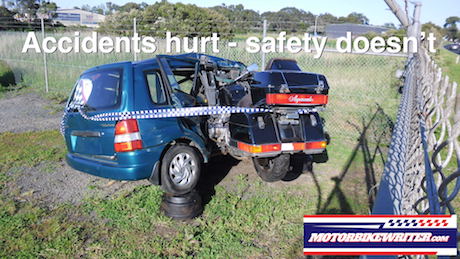Motorcycle awareness should be included in all driver training and increased in safety campaigns, according to the authors of an Australian National University study.
It found that drivers are twice as likely to miss seeing a motorcycle compared with a taxi and admit they do not expect to see motorcyclists.
Riders refer to this phenomenon as SMIDSY (Sorry Mate, I Didn’t See You), but the study refers to it as “inattentional blindness” resulting in “looked-but-failed-to-see” (LBFTS) crashes.
These are the most common type of collision involving motorcycles, according to the 2017 US Motorcycle Crash Causation Study.
The Alliance of British Drivers even produced a video which explains one of the scientific principles of SMIDSY called saccadic masking. Click here to read more.
Overloaded drivers
Now, the Australian National University study, “Allocating Attention to Detect Motorcycles: The Role of Inattentional Blindness”, has found that drivers are overloaded with more sensory information than the brain can handle.
“So our brain has to decide what information is most important,” the study reports.
“The frequency of LBFTS crashes suggests to us a connection with how the brain filters out information.”
University researchers Kristen Pammer, Stephanie Sabadas, and Stephanie Lentern asked 76 participants to look at photographs taken from the driver’s perspectives and determine if it was safe or unsafe.

The final photograph included an unexpected object, either a motorcycle or a taxi, which was not noticed by 48% of all participants.
Of those, 65% did not detect the motorcycle while 31% did not notice the taxi.
University experiments
In other experiments, drivers modulated their attention to accommodate motorcycles when necessary, suggesting that motorcycles are given the least amount of attention.
Participants said they believed a motorcycle was just as likely to be on the road as a taxi, but admitted they would be far less likely to notice the motorcycle.

However, participants who have a motorcycle licence were more likely to notice the motorcycles.
Rider aware
Kristen and her coauthors say their study highlights the need to encourage drivers to be more motorcycle-aware with special training for novice drivers.
“Motorcycles appear to be very low on the priority list for the brain when it is filtering information,” Kristen says.
“By putting motorcyclists higher on the brain ‘radar’ of the driver, hopefully drivers will be more likely to see them. In the meantime, we need to be more vigilant, more active, and more conscious when driving.”
Kristen says there are many ways drivers can be made rider-aware, including advertising campaigns.
“I would put it into driver training programs (and ongoing driver awareness programs) where everyone who drives must also experience what it is like to ride a motorbike,” says Kristen who doesn’t ride but has brothers and friends who do.
“We know that people who ride or have a friend or relative who rides are less likely to miss the motorcyclist in our study.
“If we could have everyone pass a simulator motorbike riding test – I bet it would make a big difference.”




